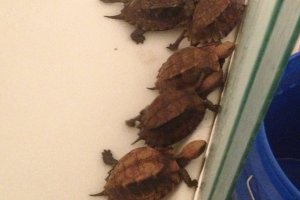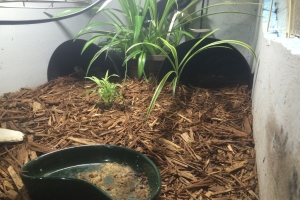Joe details a mostly-successful quarantine and acclimation of a freshly imported group of Cuora mouhotii obsti (Southern Keeled Box Turtles).
 Generally speaking, most of the captive stock in the United States of Cuora mouhotii obsti comes from importation. As a result, how soon one is able to obtain the animals from the importers is crucial for their long-term survival. The longer they sit with importers in sub-par conditions increases the risk of health complications.
Generally speaking, most of the captive stock in the United States of Cuora mouhotii obsti comes from importation. As a result, how soon one is able to obtain the animals from the importers is crucial for their long-term survival. The longer they sit with importers in sub-par conditions increases the risk of health complications.
I did make a few mistakes when my 3.4 group of Southern Keeled Box Turtles came in. The first was not knowing the exact source of the animals we were buying. As it turns out, I purchased from a middle man which I believe led to the quick deaths of a few animals, including one male who was dead-on-arrival (DOA). I would have greatly preferred purchasing directly from the importer.
Upon arrival, each of the Cuora mouhotii obsti were inspected, followed my a long soak in a 1:1 water to flavorless Pedialyte mixture with an approximate temperature of 70°F. Once their soak was completed, the animals were transferred to individual habitats which had been set up in 33-gallon plastic containers. When in quarantine, it is crucial to keep contact between the animals to an absolute minimum to help prevent and further cross-contamination. Additionally, all of these quarantine enclosures were in a separate room from all other projects to prevent introducing new pathogens to the existing residents. Additionally, gloves were worn during all interaction with these turtles. During the quarantine period, I stuck to a very strict cleaning regimen. All individual enclosures were disinfected daily to prevent any re-contamination during the medicating process. We did this cleaning during the daily out-of-enclosure soak each turtle received. Preventing continued contact with their own waste while they were being treated helps to prevent any reinfection.
 Soon after their transfer to the to the quarantine habitats, we were able to collect fecal samples and took them to our vet where after examination, we were given both anti-parasite medications and antibiotics. All of these medications were given orally; this was a great challenge as Cuora mouhotii have extremely strong jaws. I used dental picks to carefully open the beak and sanitized plastic pen caps to help keep the jaw open so I could administer the medications. As a reminder, it is of utmost importance to follow the instructions from your veterinarian for each and every medication. Because chelonian digestive systems are slow, treating for weeks is a normal occurrence. After the full course of anti-parasite was complete, we treated with the antibiotics. These drugs can be extremely rough on the turtles’ organs, so keeping them well hydrated throughout the process is a must. Once all courses of drugs were complete, we returned to the vet with fresh fecal samples to ensure that the feces were now clean.
Soon after their transfer to the to the quarantine habitats, we were able to collect fecal samples and took them to our vet where after examination, we were given both anti-parasite medications and antibiotics. All of these medications were given orally; this was a great challenge as Cuora mouhotii have extremely strong jaws. I used dental picks to carefully open the beak and sanitized plastic pen caps to help keep the jaw open so I could administer the medications. As a reminder, it is of utmost importance to follow the instructions from your veterinarian for each and every medication. Because chelonian digestive systems are slow, treating for weeks is a normal occurrence. After the full course of anti-parasite was complete, we treated with the antibiotics. These drugs can be extremely rough on the turtles’ organs, so keeping them well hydrated throughout the process is a must. Once all courses of drugs were complete, we returned to the vet with fresh fecal samples to ensure that the feces were now clean.
While the Cuora mouhotii obsti were under quarantine, I fed them a large variety of foods to help them stay healthy and gain weight (at a very minimum, maintain weight). Keeled box turtles are omnivorous feeders, meaning they will eat just about anything. A few of our animals were extremely underweight and actually floated during soaks (this could have been from gas or illness), so with the feedings it was important to allow them the secrecy to eat, but as well give them items that would stimulate feeding. We found that each turtle had their own preferences when it came down to feeding. Some ate anything offered, while others only would eat fruits or only live foods.
Feedings took place immediately after the turtles had their daily soaks. This timing was chosen because it seemed that being soaked help to stimulate feeding behavior. All of the animals would get a mix of fruits, but never seemed too keen on eating greens. Fruits that seemed to work well were bananas, kiwi, raspberries, strawberries, blueberries, and pears. Using a large variety of fruits helps to ensure the turtles get a well-rounded group of nutrients. Live foods seemed to work extremely well for getting them started eating. I personally try to avoid using live feeders with a strong chitin shell (super worms, for example) because many can cause digestion issues. So in place of those, I chose to use soft bodied worms such as earth worms and horn worms. Both of these worked extremely well. We also used pinkie mice to help bulk them up.
 Most of the group gained weight steadily through the five-month quarantine period. We did end up losing two through this process. The two that passed appeared to be the weakest of the group. The first was a small female with a very poor appetite that continued to float during soaks. The second appeared well, but never gained weight; she ended up passing from a hidden respiratory infection. Sadly, losing some of the group is a normal part of quarantine process. Sometimes, the medication used will not take as it should in specific animals, or it might have not been the correct medication to treat the specific parasite. It is very important to constantly have fecal samples looked at by vets and treat according to the findings. Once the remaining group, consisting of two males and two females, were cleared of any remaining maladies by our vet, we transferred them into more adequate enclosures.
Most of the group gained weight steadily through the five-month quarantine period. We did end up losing two through this process. The two that passed appeared to be the weakest of the group. The first was a small female with a very poor appetite that continued to float during soaks. The second appeared well, but never gained weight; she ended up passing from a hidden respiratory infection. Sadly, losing some of the group is a normal part of quarantine process. Sometimes, the medication used will not take as it should in specific animals, or it might have not been the correct medication to treat the specific parasite. It is very important to constantly have fecal samples looked at by vets and treat according to the findings. Once the remaining group, consisting of two males and two females, were cleared of any remaining maladies by our vet, we transferred them into more adequate enclosures.
Quarantining freshly imported Keeled Box Turtles is not an easy task. It involves trial and error, a great deal of effort, and a fair amount of time and luck. Before closing this blog, I want to stress cleanliness one more time. Making sure that the animals under quarantine are away from any healthy stock, you wearing gloves, and taking care of the quarantined animals last in your daily care are some of the best things you can do to help prevent reinfection and introducing new infections into your current groups. In my opinion, keeping the enclosures clean and the animals separate from each other was the greatest contributing factor to my success acclimating this group.



Pingback: theTurtleRoom Cuora mouhotii obsti Acclimation and Care - theTurtleRoom